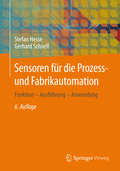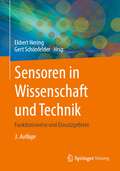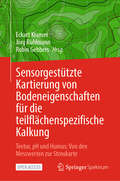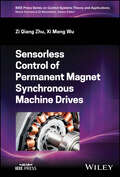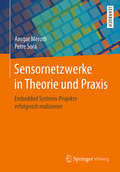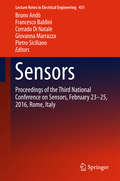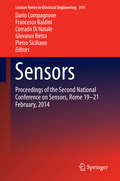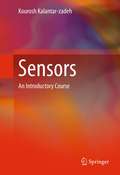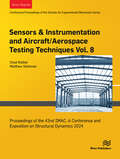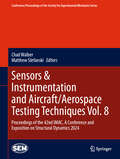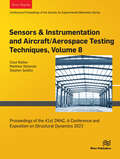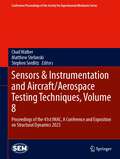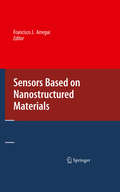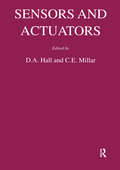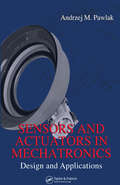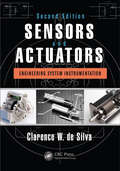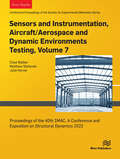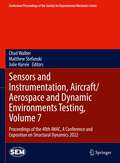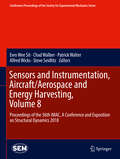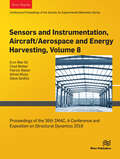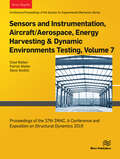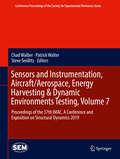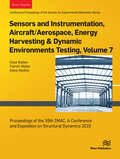- Table View
- List View
Sensoren für die Prozess- und Fabrikautomation: Funktion - Ausführung - Anwendung
by Stefan Hesse Gerhard SchnellDas inhaltlich erweiterte und in Praxis wie Ausbildung gut aufgenommene Buch bietet einen Überblick über physikalische Grundlagen und Funktionen von Sensoren in der Fabrikautomation. Es ist nach Aufgaben von Sensoren gegliedert und zeigt an vielen Beispielen Wirkungsweise und Anwendung, auch in der Robotik. Für Begriffe der Sensorik wird die englische Übersetzung angegeben. Im Minilexikon werden 264 Fachtermini erklärt.
Sensoren in Wissenschaft und Technik: Funktionsweise und Einsatzgebiete
by Ekbert Hering Gert SchönfelderDas Buch bietet einen umfassenden Überblick über physikalische Grundlagen, Funktionen und Applikationen von Sensoren. Es ist nach den Aufgabenfeldern von Sensoren gegliedert und zeigt anhand typischer Einsatzbeispiele anschaulich deren Anwendung. Sensorisch erfassbare Messgrößen sind z.B. mechanische, dynamische, thermische sowie elektrische und magnetische. Weiterhin werden auch optische und akustische Sensoren in deren Anwendung im Buch detailliert behandelt. Die Sensor-Signale werden aufgenommen, weiterverarbeitet und in Steuersignale für Aktoren umgewandelt. Solche Sensorsysteme werden ebenfalls vorgestellt.
Sensorgestützte Kartierung von Bodeneigenschaften für die teilflächenspezifische Kalkung: Textur, pH und Humus: Von den Messwerten zur Streukarte
by Eckart Kramer Jörg Rühlmann Robin GebbersDieses Open Access Buch vermittelt fundierte Grundlagen und praxisorientierte Anleitungen für die genaue Kartierung von Ackerflächen auf der Grundlage von Bodenparametern wie Textur, pH-Wert und Humusgehalt. Es werden die gegenwärtig bestgeeigneten Kartierungsverfahren beschrieben. Von der Bereinigung der Bodensensordaten bis hin zur Erstellung von Streukarten und der Auswahl des optimalen Kalkdüngers wird jeder Schritt des Prozesses detailliert erklärt. Sämtliche Funktionen und Algorithmen zum Buch sind als “R”-Skripte via Download verfügbar. Mit Hilfe von Beispieldaten und einem Tutorial kann die Prozesskette zur Streukartenerstellung mit der freien Softwareumgebung “R” als Einstieg in mathematische Methoden des Precision Farming, u.a. räumliche Statistik und Entscheidungsunterstützungsalgorithmen, nachvollzogen werden. Darüber hinaus bietet dieses Buch praktische Einblicke in die landwirtschaftliche Praxis, indem es die Bedeutung präziser Bodentexturkarten für eine effiziente Grunddüngung erläutert. Anhand von anschaulichen Praxisbeispielen werden die Auswirkungen ungenauer Bodeninformationen auf die Nährstoffversorgung des Bodens und die Umwelt verdeutlicht. Mit seinem ganzheitlichen Ansatz liefert dieses Buch nicht nur praktische Anleitungen, sondern auch wertvolles Hintergrundwissen zu Fachthemen wie Bodenacidität, Kalkdüngestoffen und Kartierungsmethoden. Es ist ein idealer Begleiter für Landwirt*innen, Berater*innen und Wissenschaftler*innen, die ihre landwirtschaftlichen Praktiken optimieren und ihre Erträge steigern möchten.
Sensorless AC Electric Motor Control
by Alain Glumineau Jesús León MoralesThis monograph shows the reader how to avoid the burdens of sensor cost, reduced internal physical space, and system complexity in the control of AC motors. Many applications fields electric vehicles, wind- and wave-energy converters and robotics, among them will benefit. Sensorless AC Electric Motor Control describes the elimination of physical sensors and their replacement with observers, i. e. , software sensors. Robustness is introduced to overcome problems associated with the unavoidable imperfection of knowledge of machine parameters resistance, inertia, and so on encountered in real systems. The details of a large number of speed- and/or position-sensorless ideas for different types of permanent-magnet synchronous motors and induction motors are presented along with several novel observer designs for electrical machines. Control strategies are developed using high-order, sliding-mode and quasi-continuous-sliding-mode techniques and two types of observer controller schemes based on backstepping and sliding-mode techniques are described. Experimental results validate the performance of these observer and controller configurations with test trajectories of significance in difficult sensorless-AC-machine problems. Control engineers working with AC motors in a variety of industrial environments will find the space-and-cost-saving ideas detailed in Sensorless AC Electric Motor Control of much interest. Academic researchers and graduate students from electrical, mechanical and control-engineering backgrounds will be able to see how advanced theoretical control can be applied in meaningful real systems. "
Sensorless Control of Permanent Magnet Synchronous Machine Drives (IEEE Press Series on Control Systems Theory and Applications)
by Zi Qiang Zhu Xi Meng WuSensorless Control of Permanent Magnet Synchronous Machine Drives A comprehensive resource providing basic principles and state-of-the art developments in sensorless control technologies for permanent magnet synchronous machine drives Sensorless Control of Permanent Magnet Synchronous Machine Drives highlights the global research achievements over the last three decades and the sensorless techniques developed by the authors and their colleagues, and covers sensorless control techniques of permanent magnet machines, discussing issues and solutions. Many worked application examples are included to aid in practical understanding of concepts. Written by pioneering authors in the field, Sensorless Control of Permanent Magnet Synchronous Machine Drives covers topics such as: Permanent magnet brushless AC and DC drives Single three-phase, dual three-phase, and open winding machines Modern control theory based sensorless methods, covering model reference adaptive system, sliding mode observer, extended Kalman filter, and model predictive control Flux-linkage and back-EMF based methods for non-salient machines, and active flux-linkage and extended back-EMF methods for salient machines Pulsating and rotating high frequency sinusoidal and square wave signal injection methods with current or voltage response, at different reference frames, and selection of amplitude and frequency for injection signal Sensorless control techniques based on detecting third harmonic or zero-crossings of back-EMF waveforms Parasitic effects in fundamental and high frequency models, impacts on position estimation and compensation schemes, covering cross-coupling magnetic saturation, load effect, machine saliency and multiple saliencies Describing basic principles, examples, challenges, and practical solutions, Sensorless Control of Permanent Magnet Synchronous Machine Drives is a highly comprehensive resource on the subject for professionals working on electrical machines and drives, particularly permanent magnet machines, and researchers working on electric vehicles, wind power generators, household appliances, and industrial automation.
Sensornetzwerke in Theorie und Praxis: Embedded Systems-Projekte erfolgreich realisieren
by Ansgar Meroth Petre SoraDas Buch bildet eine wichtige Grundlage für das Verständnis des Internet of Things, indem es einen Einblick in gängige Vernetzungsprotokolle aus der Mikrocontrollerwelt bietet und wichtige Sensoren und andere Bausteine, sowie deren Einsatz und Programmierung vorstellt. Alle gezeigten Konzepte werden durch praktische Schaltungs- und Programmierbeispiele aus den langjährigen Erfahrungen der Autoren illustriert. Daneben stehen den Lesern offene Bibliotheken für die Ansteuerung der im Buch präsentierten Bauteile auf der Verlagshomepage zum Herunterladen bereit. Die zweite Auflage beinhaltet einige neue Bausteine, insbesondere im Bereich der Netzwerke, eine ausführlichere Beschreibung der Funktionsprinzipien einiger Sensoren sowie weitere Tipps und Tricks zum Programmieren.
Sensornetzwerke in Theorie und Praxis: Embedded Systems-projekte Erfolgreich Realisieren
by Ansgar Meroth Petre SoraDas Buch bildet eine wichtige Grundlage für das Verständnis des Internet of Things, indem es einen Einblick in gängige Vernetzungsprotokolle aus der Mikrocontrollerwelt bietet und wichtige Sensoren und andere Bausteine, sowie deren Einsatz und Programmierung vorstellt. Alle gezeigten Konzepte werden durch praktische Schaltungs- und Programmierbeispiele aus den langjährigen Erfahrungen der Autoren illustriert. Daneben stehen den Lesern offene Bibliotheken für die Ansteuerung der im Buch präsentierten Bauteile auf der Verlagshomepage zum Herunterladen bereit.
Sensors
by Corrado Di Natale Pietro Siciliano Bruno Andò Francesco Baldini Giovanna MarrazzaProceedings of SPIE present the original research papers presented at SPIE conferences and other high-quality conferences in the broad-ranging fields of optics and photonics. These books provide prompt access to the latest innovations in research and technology in their respective fields. Proceedings of SPIE are among the most cited references in patent literature.
Sensors
by Corrado Di Natale Pietro Siciliano Dario Compagnone Francesco Baldini Giovanni BettaThis book contains a selection of papers presented at the Second National Conference on Sensors held in Rome 19-21 February 2014. The conference highlighted state-of-the-art results from both theoretical and applied research in the field of sensors and related technologies. This book presents material in an interdisciplinary approach, covering many aspects of the disciplines related to sensors, including physics, chemistry, materials science, biology and applications.
Sensors
by Kourosh Kalantar-ZadehSensors: An Introductory Course provides an essential reference on the fundamentals of sensors. The book is designed to help readers in developing skills and the understanding required in order to implement a wide range of sensors that are commonly used in our daily lives. This book covers the basic concepts in the sensors field, including definitions and terminologies. The physical sensing effects are described, and devices which utilize these effects are presented. The most frequently used organic and inorganic sensors are introduced and the techniques for implementing them are discussed.
Sensors & Instrumentation and Aircraft/Aerospace Testing Techniques Vol. 8: Proceedings of the 42nd IMAC, A Conference and Exposition on Structural Dynamics 2024
by Chad Walber Matthew Stefanski Dagny BealeSensors & Instrumentation and Aircraft/Aerospace Testing Techniques, Volume 8: Proceedings of the 42nd IMAC, A Conference and Exposition on Structural Dynamics, 2024, the eighth volume of ten from the Conference brings together contributions to this important area of research and engineering. The collection presents early findings and case studies on fundamental and applied aspects of Shock & Vibration, Aircraft/Aerospace Testing Techniques including papers on: Alternative Sensing & Acquisition Active Controls Instrumentation.
Sensors & Instrumentation and Aircraft/Aerospace Testing Techniques Vol. 8: Proceedings of the 42nd IMAC, A Conference and Exposition on Structural Dynamics 2024 (Conference Proceedings of the Society for Experimental Mechanics Series)
by Chad Walber Matthew StefanskiSensors & Instrumentation and Aircraft/Aerospace Testing Techniques, Volume 8: Proceedings of the 42nd IMAC, A Conference and Exposition on Structural Dynamics, 2024, the eighth volume of ten from the Conference brings together contributions to this important area of research and engineering. The collection presents early findings and case studies on fundamental and applied aspects of Shock & Vibration, Aircraft/Aerospace Testing Techniques including papers on: Alternative Sensing & Acquisition Active Controls Instrumentation
Sensors & Instrumentation and Aircraft/Aerospace Testing Techniques, Volume 8: Proceedings of the 41st IMAC, A Conference and Exposition on Structural Dynamics 2023
by Chad Walber Matthew Stefanski Stephen SeidlitzSensors & Instrumentation and Aircraft/Aerospace Testing Techniques, Volume 8: Proceedings of the 41st IMAC, A Conference and Exposition on Structural Dynamics, 2023, the eighth volume of ten from the Conference brings together contributions to this important area of research and engineering. The collection presents early findings and case studies on fundamental and applied aspects of Shock & Vibration, Aircraft/Aerospace Testing Techniques including papers on: Alternative Sensing & Acquisition Active Controls Instrumentation.
Sensors & Instrumentation and Aircraft/Aerospace Testing Techniques, Volume 8: Proceedings of the 41st IMAC, A Conference and Exposition on Structural Dynamics 2023 (Conference Proceedings of the Society for Experimental Mechanics Series)
by Chad Walber Matthew Stefanski Stephen SeidlitzSensors & Instrumentation and Aircraft/Aerospace Testing Techniques, Volume 8: Proceedings of the 41st IMAC, A Conference and Exposition on Structural Dynamics, 2023, the eighth volume of ten from the Conference brings together contributions to this important area of research and engineering. The collection presents early findings and case studies on fundamental and applied aspects of Shock & Vibration, Aircraft/Aerospace Testing Techniques including papers on:Alternative Sensing & AcquisitionActive ControlsInstrumentation
Sensors Based on Nanostructured Materials
by Francisco J. ArreguiThis book presents the many different techniques and methods of fabricating materials on the nanometer scale, and, specifically, the utilization of these resources with regard to sensors. The techniques described are studied from an application-oriented perspective, providing the reader with a perspective of the types of nanostructured sensors available that is broader than other books which concentrate on theoretical situations related to specific fabrication techniques.
Sensors and Actuators
by D.A. HallThis book contains the proceedings of a conference held at the Manchester Business School on 15-16 July 1996. It covers the topics of fundamental materials studies and the design and fabrication of prototype devices, and represents a cross section of the UK activity in sensors and actuators.
Sensors and Actuators in Mechatronics: Design and Applications
by Andrzej M PawlakFrom large-scale industrial systems to components in consumer applications, mechatronics has woven itself into the very fabric of modern technology. Among the most important elements of mechatronic systems are electromagnetic sensors and electromechanical actuators. Cultivated over years of industrial and research experience, Sensors and Actuators in Mechatronics: Design and Applications builds a practical understanding of the features and functions of various electromagnetic and electromechanical devices necessary to meet specific industrial requirements.This work focuses on various components that receive less attention in the available literature, such as magnetic sensors, linear and latching solenoid actuators, stepper motors, rotary actuators, and other special magnetic devices including magnetic valves and heart pumps. Each chapter follows a consistent format, working from theory to design, applications, and numerical problems and solutions. Although the crux of the coverage is design and application, the author also discusses optimization and testing, introduces magnetic materials, and shares his enlightened perspective on the social and business aspects of developing world-class technologies. Examples from mainly the automotive industry illustrate the wide variety of mechatronic devices presented.Providing a complete picture from conception to completion, Sensors and Actuators in Mechatronics: Design and Applications places critical tools in the hands of any researcher or engineer seeking to develop innovative mechatronic systems.
Sensors and Actuators: Engineering System Instrumentation, Second Edition
by Clarence W. de SilvaAn engineering system contains multiple components that interconnect to perform a specific task. Starting from basic fundamentals through to advanced applications, Sensors and Actuators: Engineering System Instrumentation, Second Edition thoroughly explains the inner workings of an engineering system. The text first provides introductory material-p
Sensors and Instrumentation, Aircraft/Aerospace and Dynamic Environments Testing, Volume 7: Proceedings of the 40th IMAC, A Conference and Exposition on Structural Dynamics 2022
by Chad Walber Matthew Stefanski Julie HarvieSensors and Instrumentation, Aircraft/Aerospace and Energy Harvesting, Volume 7: Proceedings of the 40th IMAC, A Conference and Exposition on Structural Dynamics, 2020, the seventh volume of nine from the Conference brings together contributions to this important area of research and engineering. The collection presents early findings and case studies on fundamental and applied aspects of Shock & Vibration, Aircraft/Aerospace, Energy Harvesting & Dynamic Environments Testing including papers on: Alternative Sensing & Acquisition Active Controls Instrumentation Aircraft/Aerospace & Aerospace Testing Techniques Energy Harvesting.
Sensors and Instrumentation, Aircraft/Aerospace and Dynamic Environments Testing, Volume 7: Proceedings of the 40th IMAC, A Conference and Exposition on Structural Dynamics 2022 (Conference Proceedings of the Society for Experimental Mechanics Series)
by Chad Walber Matthew Stefanski Julie HarvieSensors and Instrumentation, Aircraft/Aerospace and Energy Harvesting, Volume 7: Proceedings of the 40th IMAC, A Conference and Exposition on Structural Dynamics, 2020, the seventh volume of nine from the Conference brings together contributions to this important area of research and engineering. The collection presents early findings and case studies on fundamental and applied aspects of Shock & Vibration, Aircraft/Aerospace, Energy Harvesting & Dynamic Environments Testing including papers on:Alternative Sensing & AcquisitionActive ControlsInstrumentationAircraft/Aerospace & Aerospace Testing Techniques Energy Harvesting
Sensors and Instrumentation, Aircraft/Aerospace and Energy Harvesting , Volume 8: Proceedings Of The 36th Imac, A Conference And Exposition On Structural Dynamics 2018 (Conference Proceedings of the Society for Experimental Mechanics Series)
by Evro Wee Sit Alfred Wicks Chad Walber Patrick Walter Steve SeidlitzSensors and Instrumentation, Volume 8. Proceedings of the 36th IMAC, A Conference and Exposition on Structural Dynamics, 2018, the eighth volume of nine from the Conference brings together contributions to this important area of research and engineering. The collection presents early findings and case studies on fundamental and applied aspects of Sensors and Instrumentation, including papers on:Sensor ApplicationsAccelerometer DesignAccelerometer CalibrationSensor Technology Energy Harvesting TechnologyAircraft/Aerospace Technology
Sensors and Instrumentation, Aircraft/Aerospace and Energy Harvesting , Volume 8: Proceedings of the 36th IMAC, A Conference and Exposition on Structural Dynamics 2018
by Evro Wee Sit Alfred Wicks Chad Walber Patrick Walter Steve SeidlitzSensors and Instrumentation, Volume 8. Proceedings of the 36th IMAC, A Conference and Exposition on Structural Dynamics, 2018, the eighth volume of nine from the Conference brings together contributions to this important area of research and engineering. The collection presents early findings and case studies on fundamental and applied aspects of Sensors and Instrumentation, including papers on: Sensor Applications Accelerometer Design Accelerometer Calibration Sensor Technology Energy Harvesting Technology Aircraft/Aerospace Technology.
Sensors and Instrumentation, Aircraft/Aerospace, Energy Harvesting & Dynamic Environments Testing, Volume 7: Proceedings of the 37th IMAC, A Conference and Exposition on Structural Dynamics 2019
by Chad Walber Patrick Walter Steve SeidlitzSensors and Instrumentation, Aircraft/Aerospace and Energy Harvesting, Volume 7: Proceedings of the 37th IMAC, A Conference and Exposition on Structural Dynamics, 2019, the seventh volume of eight from the Conference brings together contributions to this important area of research and engineering. The collection presents early findings and case studies on fundamental and applied aspects of Shock & Vibration, Aircraft/Aerospace, Energy Harvesting & Dynamic Environments Testing including papers on: Alternative Sensing & Acquisition Active Controls Instrumentation Aircraft/Aerospace & Aerospace Testing Techniques Energy Harvesting.
Sensors and Instrumentation, Aircraft/Aerospace, Energy Harvesting & Dynamic Environments Testing, Volume 7: Proceedings of the 37th IMAC, A Conference and Exposition on Structural Dynamics 2019 (Conference Proceedings of the Society for Experimental Mechanics Series)
by Chad Walber Patrick Walter Steve SeidlitzSensors and Instrumentation, Aircraft/Aerospace and Energy Harvesting, Volume 7: Proceedings of the 37th IMAC, A Conference and Exposition on Structural Dynamics, 2019, the seventh volume of eight from the Conference brings together contributions to this important area of research and engineering. The collection presents early findings and case studies on fundamental and applied aspects of Shock & Vibration, Aircraft/Aerospace, Energy Harvesting & Dynamic Environments Testing including papers on:Alternative Sensing & AcquisitionActive ControlsInstrumentationAircraft/Aerospace & Aerospace Testing Techniques Energy Harvesting
Sensors and Instrumentation, Aircraft/Aerospace, Energy Harvesting & Dynamic Environments Testing, Volume 7: Proceedings of the 38th IMAC, A Conference and Exposition on Structural Dynamics 2020
by Chad Walber Patrick Walter Steve SeidlitzSensors and Instrumentation, Aircraft/Aerospace and Energy Harvesting, Volume 7: Proceedings of the 38th IMAC, A Conference and Exposition on Structural Dynamics, 2020, the seventh volume of eight from the Conference brings together contributions to this important area of research and engineering. The collection presents early findings and case studies on fundamental and applied aspects of Shock & Vibration, Aircraft/Aerospace, Energy Harvesting & Dynamic Environments Testing including papers on: Alternative Sensing & Acquisition Active Controls Instrumentation Aircraft/Aerospace & Aerospace Testing Techniques Energy Harvesting.
